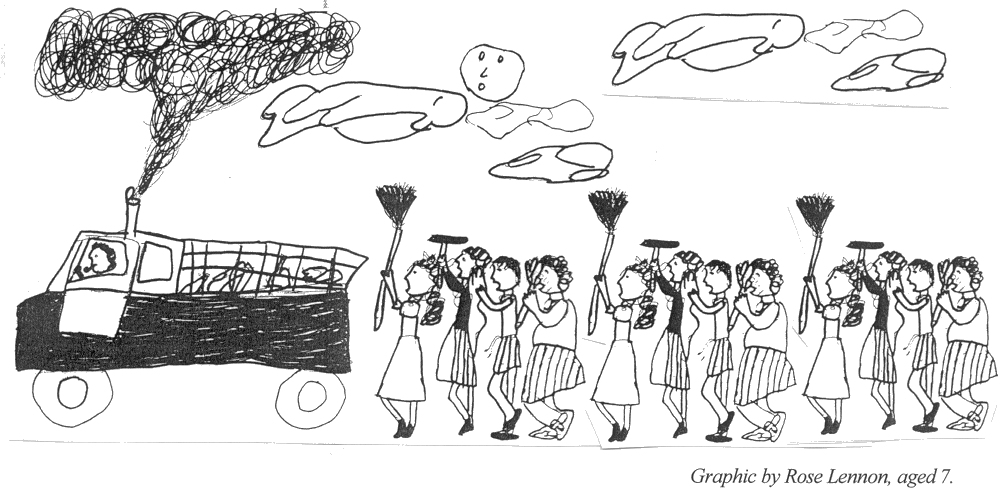|
|
||||
|
LEAD Action News Vol 3 no 2 Autumn 1995 ISSN 1324-6011 |
||||
|
About Us
|
by Elizabeth 0 'Brien Using the terms of the dominant patriarchal culture the growth in gross domestic product (GDP) in Australia between 1994 and 2003 is expected to be steady, with an average GDP of around 2.3% per annum. In that time the population growth is expected to be around 1.2%, yet the growth in the stock of motor vehicles is expected to be around 2%. In 1994 while population growth was 1.2% the growth in the stock of motor vehicles was double that at 2.4%. The vehicle kilometres travelled, i.e. the distance travelled by each vehicle is expected to rise steadily in the period. People will have more cars and travel further in them. On the other hand, the domestic supply of crude oil, condensate and liquid petroleum gas is expected to decrease during the period, so that from a peak in 1995 of 87% self sufficiency in petroleum, we are expected to have a decline to 41% self sufficiency in the year 2003, just eight years away. During this time, crude oil prices in real US dollars 1994 value are expected to increase from an average of 16.44 in 1994 to 20.86 in the year 2003. More people using more cars travelling greater distances at higher prices, but with a growth in real Gross Domestic Product of around 3.1%. If all this makes no sense to you, join the club. At The Women and Environment Conference in Melbourne in March 1995 organised by the Australian Conservation Foundation, a paradigm shift was suggested. The above example about petroleum is just one of many of the ways that we are deceived into believing that growth in the use of our resources is a good thing economically. The paradigm shift that is required is to factor in to our national accounting system, the work that the environment contributes and the work that women contribute, in the main, because women are unpaid workers. These two areas are not currently accounted for in the United Nations System of National Accounting (UNSNA). At the moment the environment is seen as a completely free source of resources and as an infinite sink for contamination, pollution products of the life style that we have created. That is the environments contribution. If we started to account for environmental degradation and to see these finite resources such as fossil fuels as being worth something to the earth, to all of us, to future generations, we would have a very different measure of our effect through what is now known as "economic growth". We would, in fact see negative effects on our planet which to any observer are obvious. Yet they are not recorded in economic analyses. Lead provides us with an archetypal example of Economic success" as defined by the patriarchal system. Lead is a natural component of crude oil. 'That's why unleaded petrol is not lead free petrol. Lead is used in boy's toys and has been for hundreds of years. We are using more lead for lead acid batteries and for ammunition (and cable sheathing) every year, whereas, due to the occupational and public health and environmental risks lead poses, all other uses of lead are declining. You can't have guns without lead. Or at least you couldn't until recently. You can't have cars without lead. There is no such thing as a lead free car. Even the zero emission vehicles being touted as the answer to our pollution problems from motor vehicles, use twice as much lead as traditional vehicles in the battery. The battery is not the only use of lead in cars, it is used in engines and A metallic parts, there's been an awakening to the environmental and health disaster that adding lead to petrol causes, and some progress on that (you can read about that in another story in this newsletter), but what about lead and militarism? Militarism is good for the economy. In a paradigm shift such as we are suggesting at the Women and Environment Conference, militarism, the production of weapons, the arms trade and dealing in money, which creates an incredibly large contribution to our economy at the moment, would not be counted any longer. On the other hand the destruction wrought by the sale of weapons, by the making of weapons, by the taking of resources from the ground and the contamination of the planet would be taken into account. Militarism would no longer be justified. Lead has had an essential role in the development of weapons. Even nuclear weapons use components which degrade to lead. Hundreds of thousands of years after nuclear weapons have radioactively decayed we will be left with massive lead contamination. The Chernobyl Meltdown contained massive lead contamination at the time it happened because lead is used as radiation shielding. Tonnes of lead were melted that day and remain in the ground.
But what of lead in the economy, other than militarism and other than motor vehicles? Apparently you can't make electronics equipment without lead, lead is used in radiation shielding and glass, on computer screens, television screens and in hospitals. Lead is used in chemicals, the ratio of lead used in chemicals is increasing, the total amount of lead produced in the world is constantly increasing, and with the growth in the population of motor vehicles and ammunition use, there seems no end to that increase. So in Australia we have a four hundred million dollar export industry in lead; therefore it is justified to remove lead from the ground forever where it was safe and non polluting, to contaminate mining communities, to contaminate vast tracts of land between mining and smelting communities due to faulty transporting practices, to contaminate the environments of our smelting communities, to poison people and every other species. This lead export then goes to other countries and our government claims that it has no trans-boundary effects, and therefore the trade of lead should not be controlled, by the OECD. If it has no trans-boundary effects why would anyone buy it? Where does our lead go? What is it used for? What would an analysis of its life cycle show us? Life cycle analyses have been undertaken in Toronto. The Canadian lifestyle is so developed now, that were everyone on the planet to have a similar lifestyle, the amount of space required to support that lifestyle would be the equivalent of not one but two extra earths. We do not have an infinite resource which we can plunder, the earth is not an infinite sink to absorb our contaminants. In intergenerational equity terms, the lead industry is a crime against our children. In social justice terms the poor suffer the most from lead contamination: the poor who can't afford to live anywhere but mining or smelting communities, the poor who live in the inner cities, along busy roads or in older housing, the poor who can't afford anything but a pre 1986 vehicle in Australia and poorer countries who are now importing lead and other toxins in order to catch up with our developed country lifestyle. As Octel (the world's only producer of the lead additive for petrol) found, if you can't sell lead to developed countries then you can guarantee its sale to underdeveloped or developing countries, by having legislation in those countries which allows the sale of vehicles that can only run on leaded petrol, nearly ten years after Australian vehicles were all designed to run on unleaded petrol. And our lead industry says that if the OECD seeks to control how much we export, and for what purposes, to OECD countries, they will simply have to take their product to non-OECD countries. They see that as an imposition m them. But they will deal with it in the bid to sell more lead. What is required in order to reduce the drain on resources that the lead industry creates, and the ceaseless addition of lead to our air, water, sediments, dust soil, sewage sludge, solid waste stream and food? What is required is a turnaround in the growth of the sale of motor vehicles. Lead acid batteries currently take up 64% of world production of lead. The projection is that in less than a decade that will be 70%, if the growth of motor vehicles is stopped, if we start reclaiming our cities to be liveable places where public transport is safe, reliable, fast, efficient and does not provide us with endless congested traffic and pollution, then we can have less lead mined and smelted in the world. There has been enough lead taken out of the ground that with careful recycling we should never need to take any more. The lead industry claims massive success in recycling lead acid batteries and yet the amount of lead taken out of the ground grows every year. Why? Sixty four percent of our lead is in lead acid batteries and 93% of that is recycled. We should be taking less out of the ground every year. One thing that the industry never mentions is that one third of the lead acid battery recycling of Australian batteries occurs via the export of lead acid batteries to Third World Countries in the Asian region, in contravention of the Basel Convention which forbids the trade from OECD Countries to non-OECD countries of hazardous waste. |
|||
|
About
Us |
bell
system lead poisoning |
Contact Us
| Council
LEAD Project | egroups | Library
- Fact Sheets | Home
Page | Media Releases Newsletters | Q & A | Referral lists | Reports | Site Map | Slide Shows - Films | Subscription | Useful Links | Search this Site |
||||
|
Last
Updated 15 November 2012
|
||||

 Women and the Environment Conference
Women and the Environment Conference